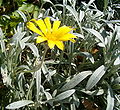Biology:Gazania rigens
| Gazania rigens | |
|---|---|

| |
| Scientific classification | |
| Kingdom: | Plantae |
| Clade: | Tracheophytes |
| Clade: | Angiosperms |
| Clade: | Eudicots |
| Clade: | Asterids |
| Order: | Asterales |
| Family: | Asteraceae |
| Genus: | Gazania |
| Species: | G. rigens
|
| Binomial name | |
| Gazania rigens (L.) Gaertn.
| |
| Synonyms | |
| |
Gazania rigens (syn. G. splendens), sometimes called treasure flower, is a species of flowering plant in the family Asteraceae, native to coastal areas of southern Africa. It is naturalised elsewhere and is widely cultivated as an ornamental plant.
Description
Gazania rigens is a spreading, low-growing, half-hardy perennial, growing to 50 cm (20 in) tall and wide, with blue-grey foliage and brilliant yellow, daisy-like composite flowerheads throughout the summer. It is a herbaceous plant that is perennial in South Africa and in the Mediterranean regions, and annual in the gardens of colder regions. It rarely exceeds 30 cm (12 in) and forms tufts, often very abundant. Its leaves all basal, numerous, narrow and more or less lanceolate, usually entire, sometimes pennatilobed. The obverse of the leaves is shiny green, the grayish white lapel.
Like all compounds, gazania flowers in flower heads that are often taken for simple flowers. The capitula are solitary at the end of peduncles just beyond the leaves. Each capitulum is formed by a central disc of tubular flowers, surrounded by ligulate peripheral flowers, whose color is very variable. The orange-yellow flowers are however the most numerous, often with black spots at the base of the ligules. The fruit is an achene, containing several seeds.
Naturalisation
Well adapted to the Mediterranean climate, it is native to South Africa and Mozambique. It has become naturalised on the Mediterranean shores, and in places like the Azores, Australia, New Zealand, the United Kingdom, France, Portugal, California, and Argentina. The generic name of the plant is dedicated to Theodore of Gaza (1398-1478), who translated the botanical works of Theophrastus, from Greek to Latin.[citation needed] It is a weed in the islands of Madeira, Sicily and Sardinia[citation needed].
In Australia, where it is known as coastal gazania, the species has become naturalised on coastal dunes and roadsides in the Central Coast and Sydney regions of New South Wales as well as the coast of South East Queensland. In South Australia it is found in the southern Mount Lofty area as well as on the Eyre peninsula.[1][2]
Cultivation
Gazania rigens is grown for the brilliant yellow of its blooms which appear against blue-grey foliage in the late spring and throughout the summer. Plants prefer a sunny position and are tolerant of dryness and poor soils. Quite indifferent to the nature of the soil, it looks especially for the sun, its flower heads closing when it is in the shade or when the weather is overcast. It adapts well to drought, heat and strong sun, unlike many other flowers.[3][4]
Flowering from March to October in the northern hemisphere, the flowers are however more numerous and larger in the spring.[5] In temperate regions this plant is usually grown as a half-hardy annual, though it can tolerate light frosts.[3]
Varieties
The currently recognised varieties are:[6]
- G. rigens (L.) Gaertn. var. leucolaena (DC.) Roessler. This variety has grey-white leaves. Its flower heads are yellow, typically without any basal eye-spots. It naturally occurs along the southern coast of South Africa , from Mossel Bay in the west, to Port Elizabeth in the east.[7]
- G. rigens (L.) Gaertn. var. rigens This variety is distinguished by its large 4- to 8-cm flower heads with yellow or orange rays, each with a basal eye-spot. It is only found in cultivation.[8]
- G. rigens (L.) Gaertn. var. uniflora (L.f.) Roessler This variety has leaves that are smooth and green on their upper surface. Its flower heads are yellow, typically without any basal eye-spots. It naturally occurs along the east coast of South Africa , from Knysna in the west, to southern Mozambique in the east. Where its range overlaps with that of G. rigens var. leucolaena, the two varieties often grow alongside each other.[9]
Gallery
See also
References
- ↑ "Weeds Australia - Weed Identification - Gazania". Archived from the original on 2008-05-14. https://web.archive.org/web/20080514230853/http://www.weeds.org.au/cgi-bin/weedident.cgi?tpl=plant.tpl&ibra=all&card=E18. Retrieved 2008-04-11.
- ↑ "Genus Gazania rigens". PlantNET - New South Wales Flora Online. Royal Botanic Gardens & Domain Trust, Sydney Australia. http://plantnet.rbgsyd.nsw.gov.au/cgi-bin/NSWfl.pl?page=nswfl&lvl=sp&name=Gazania~rigens. Retrieved 2008-04-11.
- ↑ 3.0 3.1 Gazania Growing Guide Growing Interactive Ltd. Retrieved 1 April 2023.
- ↑ Gazania (Treasure Flower) Gardenia.net. Retrieved 1 April 2023.
- ↑ Arthurs, Kathryn L., ed (1979). Lawns & Groundcovers. Lane Publishing Co.. ISBN 0-376-03507-2. https://archive.org/details/lawnsgroundcover00arth.
- ↑ "African plants database". http://www.ville-ge.ch/cjb/bd/africa/resultat.php. Retrieved 2008-04-11.
- ↑ "Gazania rigens var. Leucolaena | PlantZAfrica". http://pza.sanbi.org/gazania-rigens-var-leucolaena.
- ↑ "Aluka - Entry for Gazania rigens var. uniflora L.f. Roessler family Compositae". http://www.aluka.org/action/showMetadata?doi=10.5555/AL.AP.FLORA.FZ5063&pgs=. Retrieved 2008-04-11.
- ↑ "Gazania rigens var. Leucolaena | PlantZAfrica". http://pza.sanbi.org/gazania-rigens-var-leucolaena.
External links
Wikidata ☰ Q775301 entry
 |





